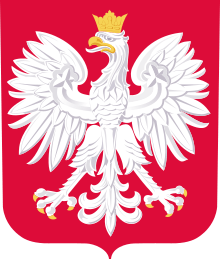Polish Armed Forces
| Armed Forces of the Republic of Poland | |
|---|---|
| Siły Zbrojne Rzeczypospolitej Polskiej | |
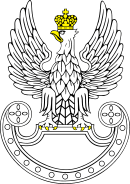 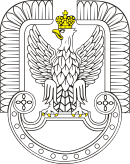 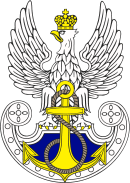 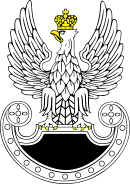 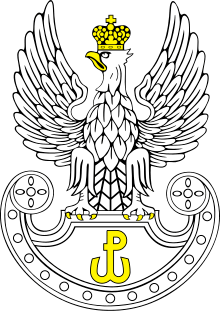 | |
| Motto |
God, Honor, Fatherland (Bóg, Honor, Ojczyzna) |
| Service branches |
Polish Land Forces Polish Air Forces Polish Navy Polish Special Forces Polish Territorial Defence Forces |
| Leadership | |
| President Supreme Commander |
|
| Minister of National Defence |
|
| Chief of the General Staff |
|
| Manpower | |
| Military age | 18 years of age |
| Conscription | No (since January 2009) |
| Available for military service | 18,830,448, age 15–49 (2015 est.) |
| Fit for military service | 15,583,917, age 15–49 (2015 est.) |
| Reaching military age annually | 515,000 (2015 est.) |
| Active personnel | 105,000 (2017)[1] (ranked 42nd) |
| Reserve personnel | 24,000 (National Reserve Forces and cadets)[1] |
| Expenditures | |
| Budget | PLN 41.1 billion (~€10 billion, ~$12.2 billion) (2018)[2] |
| Percent of GDP | 2.0% (2018) |
| Industry | |
| Domestic suppliers |
Polish Defence Holding WZM S.A. PZL-Świdnik HSW S.A. OBRUM |
| Related articles | |
| History |
List of Polish wars Timeline of the Polish Army |
| Ranks | Polish Armed Forces rank insignia |
The Armed Forces of the Republic of Poland (Polish:Siły Zbrojne Rzeczypospolitej Polskiej, abbreviated SZ RP; popularly called Wojsko Polskie in Poland, abbreviated WP—roughly, the "Polish Military") are the national armed forces of the Republic of Poland. The name has been used since the early 19th century, but can also be applied to earlier periods.
The Armed Forces of the Republic of Poland are the Wojska Lądowe (Polish Land Forces), Marynarka Wojenna (Polish Navy), Siły Powietrzne (Polish Air Forces), Wojska Specjalne (Polish Special Forces) and Wojska Obrony Terytorialnej (Polish Territorial Defence Forces) which are under the command of the Ministerstwo Obrony Narodowej Rzeczypospolitej Polskiej (Ministry of National Defense of Poland).
From 2002 until 2014, Polish military forces were part of the Coalition Forces that participated in the ISAF mission in Afghanistan led by NATO. Poland's contribution to ISAF was the country's largest, since its entrance into NATO.
Polish forces also took part in the Iraq War. From 2003 to 2008, Polish military forces commanded the Multinational Division (MND-CS) located in the South-Central Occupation Zone of Iraq. The division was made up of troops from 23 nations and totaled as many as 8,500 soldiers. It is regarded as one of the most professional militaries in Europe.
Mission
Pursuant to the national security strategy of Poland, the supreme strategic goal of Poland's military forces is to ensure favourable and secure conditions for the realization of national interests by eliminating external and internal threats, reducing risks, rightly assessing undertaken challenges, and ably using existing opportunities.[3] The Republic of Poland’s main strategic goals in the area of defence include:
- ensuring the independence and sovereignty of the Republic of Poland, as well as its integrality and the inviolability of its borders;
- defence and protection of all the citizens of the Republic of Poland;
- creating conditions to ensure the continuity of the implementation of functions by public administration authorities and other entities competent in the area of national security, including entities responsible for running the economy and for other areas important for the life and security of its citizens;
- creating conditions for the improvement of the state’s national defence capabilities and ensuring defence readiness in allied structures;
- developing partnership military cooperation with other states, especially neighbouring ones;
- implementing commitments arising from Poland’s NATO and European Union membership;
- engaging in international crisis response operations led by NATO, the EU, the UN, and as a part of emergency coalitions.
History

The List of Polish wars chronicles Polish military involvements since the year 972. The present armed forces trace their roots to the early 20th century, yet the history of Polish armed forces in their broadest sense stretches back much further. After the partitions of Poland, during the period from 1795 until 1918, Polish military was recreated several times during national insurrections that included the November Uprising of 1830, and the January Uprising in 1863, and the Napoleonic Wars that saw the formation of the Polish Legions in Italy. The Kingdom of Poland, being part of the Russian Empire with a certain degree of autonomy, had a separate Polish army in the years 1815–1830, which was disbanded after the unsuccessful November Uprising. Large numbers of Poles also served in the armies of the partitioning powers, Russian Empire, Austria-Hungary (before 1867 Austria) and Germany (before 1871 Prussia). However, these powers took care to spread Polish soldiers all over their armies and as a rule did not form predominantly Polish units.
During World War I, the Polish Legions were set up in Galicia, the southern part of Poland under Austrian occupation. They were both disbanded after the Central Powers failed to provide guarantees of Polish independence after the war. General Józef Haller, the commander of the Second Brigade of the Polish Legion, switched sides in late 1917, and via Murmansk took part of his troops to France, where he created the Blue Army. It was joined by several thousand Polish volunteers from the United States. It fought on the French front in 1917 and 1918.
The Polish Army was recreated in 1918 from elements of the three separate Russian, Austro-Hungarian, and Prussian armies, and armed with equipment left following World War I. The force expanded during the Polish–Soviet War of 1919–1922 to nearly 800,000 men, but then was reduced when peace was reestablished.
World War II
At the onset of World War II, on 1 September 1939 Nazi Germany invaded Poland. Polish forces were overwhelmed by the German attack in September 1939, which was followed on 17 September 1939 by an invasion by the Soviet Union. Some Polish forces escaped from their occupied, divided country, and joined Allied forces fighting in other theatres while those that remained in Poland splintered into guerilla units of the Armia Krajowa ("Home Army") and other partisan groups which fought in clandestine ways against the foreign occupiers of Poland. Thus there were three threads to Polish armed forces from 1939; the Polish Armed Forces in the West, the Armia Krajowa and other resistance organisations fighting the Germans in Poland, and the Polish Armed Forces in the East, which later became the post-war communist Polish People's Army (LWP).
.jpg)
The Polish Armed Forces in the West comprised army, navy, and air force units, and were loyal to the Polish government-in-exile. Army formations and units included the Polish Army in France (1939–1940), the Polish I Corps in the West, the Polish II Corps, and the rump Command in the Middle East that was briefly designated the III Corps.[4] Amongst their most notable operations were the actions of the 1st Armoured Division at Mont Ormel, during the Normandy campaign, the Battle of Monte Cassino (Operation Diadem) scaling of the mountain by elements of II Polish Corps, and actions during the Battle of Arnhem by the 1st Polish Parachute Brigade.[5] The Polish Air Forces in France and Great Britain numbered fifteen squadrons under Royal Air Force and Army Air Corps operational control, as well as units under the direction of the French Air Force. The Polish Air Force fought in the Battle of France as one fighter squadron (GC 1/145), several small units detached to French squadrons, and numerous industry defence flights (approximately 130 pilots, who achieved 55 victories at a loss of 15 men).[6] Naval units comprised three destroyers of the Polish Navy that had escaped from Poland under the Peking Plan to fight alongside the Western allies from Britain, as well as many other vessels that later came to be manned by Polish crews under Royal Navy auspices. These vessels included the cruisers ORP Dragon and Conrad, seven destroyers, three Type II Hunt class destroyers, and five submarines.
What later became the communist LWP was formed during the Second World War as the Polish 1st Tadeusz Kościuszko Infantry Division, also unofficially known as the Berling Army. The majority of officers were Polish. The first Polish force formed in the USSR, the Anders Army, had by that time moved to Iran. Polish forces soon grew beyond the 1st Division into two major commands—the First Polish Army (Berling's) and the Polish Second Army (commanded by Karol Świerczewski). The Polish First Army participated in the Vistula–Oder Offensive and the Battle of Kolberg (1945) before participating in its final offensive with the Battle of Berlin. The Polish Second Army served under command of the Soviet 1st Ukrainian Front in 1945 and fought in the vicinity of Bautzen and Dresden. In the east these two armies were supported at times by Polish air units, part of the Air Force of the Polish Army.
The communist-aligned Polish military formation was the People's Army of Poland, formed in the Soviet Union and partially integrated with Red Army formations. It became the core of the armed forces of post-war Poland. It was known officially as the Armed Forces of the Republic of Poland from 1945 to 1952 (the same as the current name), and Armed Forces of People's Republic of Poland from 1952 to 1990, reflecting the country's name change from Republic of Poland to People's Republic of Poland.
After 1945
.jpg)
The first postwar Minister of National Defence was Marszałek Polski Michał Rola-Żymierski, promoted by Stalin's order to the rank of Marshal of Poland on 3 May 1945. However, Michta writes that while the 'army was formally under Zymierski's command until 1949, it was ultimately controlled by two Soviet officers, Generals Korczyc and Poplawski.'[7] From 1949 to 1956 the Polish armed forces were under the command of Zymierski's successor as Minister of National Defense, Marshal of the Soviet Union Konstantin Rokossovsky, who was given the additional title Marshal of Poland. Rokossovsky was succeeded by Marian Spychalski, who was released from prison to take the post. The People's Army of Poland was prepared to defend the country against a possible new invasion from the West (based on the plan by Stefan Mossor). It was increasingly tied into the Soviet structures. This process was however stopped in the aftermath of the Polish October in 1956, however, and brigades and regiments began to be formed in the engineering, artillery and communications arms.
1954 would see the Air Force and the Air Defense Forces merged into the Polish Air and National Air Defense Forces, a process that would last till 1962 (this would happen again in 1990).
After the war the Polish Army was reorganized into six (later seven) military districts. These were the Warsaw Military District, headquarters (HQ) in Warsaw, the Lublin Military District, HQ in Lublin, the Kraków Military District, HQ in Kraków, the Łódź Military District, HQ in Lodz, the Poznań Military District, HQ in Poznan, the Pomeranian Military District, HQ in Torun, and the Silesian Military District, HQ in Katowice, created in autumn 1945. They were later reduced to four, then three and later into the two military districts active as of 2011.
Until the fall of communism the army's prestige continued to fall, as it was used by the communist government to resettle ethnicities immediately after the war (Operation Vistula), and to violently suppress opposition several times, during the Poznań 1956 protests, the Polish 1970 protests, and during Martial law in Poland in 1981–1982. The LWP also took part in the suppressing of the 1968 democratization process of Czechoslovakia, commonly known as the Prague Spring. That same year Marshal of Poland Marian Spychalski was asked to replace Edward Ochab as chairman of the Council of State, and General Wojciech Jaruzelski, at that time the Chief of the General Staff, was named to replace him.[8] Michta argues that Jaruzelski, as a known Soviet loyalist, reflected the Soviet decision to 'put a trusted group of officers in control of one of the least trusted armies in the Warsaw Pact forces.'[9] The command post for the 1968 Warsaw Pact invasion of Czechoslovakia was actually located on Polish soil, at Marshal Ivan Yakubovsky's Legnica headquarters.[10]
In 1953 Poland began to make contributions to peacekeeping operations, initially the Neutral Nations Supervisory Commission on the North Korean/South Korean border, where it maintained personnel until 1995.[11] From 1953–1973 Poland military and civilian personnel also took part in the International Commission for Supervision and Control in Indochina and the International Group of Observers in Nigeria.[12] Poland has maintained for decades a long-standing commitment to the United Nations Interim Force in Lebanon (500 personnel). The Polish Armed Forces took part in the United Nations-sanctioned coalition during the Gulf War in 1991, deploying two ships, the Piast and Wodnik, and a medical team (see pl:PKW Zatoka Perska (1991)). In 1994–95 53 GROM special forces personnel were despatched to Haiti for Operation Uphold Democracy.
Third Polish Republic (1989–today)
After January 1990 the name of the armed forces was changed to 'Armed Forces of the Republic of Poland,' to accord with the Polish State's new official name.
.jpg)
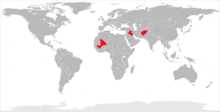
In March 2003 the Polish Armed Forces took part in the 2003 invasion of Iraq, deploying special forces and a support ship.[13] Following the destruction of Saddam's regime the Polish Land Forces supplied a brigade and a division headquarters for the 17-nation Multinational Division Central-South, part of the U.S.-led Multi-National Force Iraq. At its peak Poland had 2,500 soldiers in the south of the country. Other completed operations include 2005 'Swift Relief' in Pakistan, in which NATO Response Force-allocated personnel were despatched. Polish Land Forces personnel sent to Pakistan included a Military Engineers company, a platoon of the 1st Special Commando Regiment, and a logistics component from the 10th Logistics Brigade. Elsewhere, Polish forces were sent to MINURCAT in Chad and the Central African Republic (2007–2010). As of 2008, Poland had deployed 985 personnel in eight separarate UN peacekeeping operations (the United Nations Disengagement Observer Force, MINURSO, MONUC, UNOCI, UNIFIL, UNMEE, UNMIK, UNMIL, and UNOMIG).[14]
A new joint operational headquarters, the Dowodztwo Operacyjne (DO) was planned to declare its initial operating capability on 1 January 2005, and full operational capability on 1 July 2005.[15] The DO was created on 22 October 2003, with the first officers being assigned in the second quarter of 2004. Most of the headquarters' 110 military staff were planned to be transferred from the 1st Mechanised Corps headquartered at Bydgoszcz, which was disbanded in 2004.
Formerly organised according to Warsaw Pact standards, the armed forces are currently being reorganised according to NATO standards. 'Eagle Guardian' is apparently the NATO planning designation for contingency plans to deploy and defend Poland and the Baltic States.[16] Poland is also playing an increasingly larger role as a major European peacekeeping power in the world through various UN peacekeeping actions, and cooperation with neighbouring nations through multinational formations and units such as the Multinational Corps Northeast and POLUKRBAT. As of 1 January 2010, the Armed Forces of the Republic of Poland have transitioned to a completely contract-based manpower supply system.
On 10 April 2010 a Polish Air Force Tu-154M crashed near Smolensk, Russia while in transit to a ceremony commemorating the Katyn massacre. On board the plane were the President (Commander-in-Chief), the Chief of Staff, all four Branch Commanders of the Polish Military, and a number of other military officials; all were killed. However, the Minister of Defense stayed in Warsaw, avoiding the crash in the process.
In 2014-2015 the Armed Forces General Command and Armed Forces Operational Command were both established, virtually eliminating the single services.
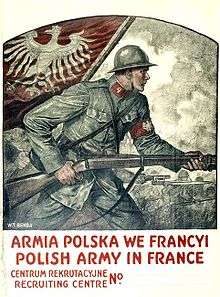 World War I recruitment poster for Polish Army in France
World War I recruitment poster for Polish Army in France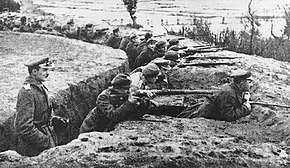 Polish soldiers during Polish–Soviet War
Polish soldiers during Polish–Soviet War.jpg) King Carol II of Romania decorates a standard of the 57th Infantry Regiment, of which he had taken an honorary command, 1937
King Carol II of Romania decorates a standard of the 57th Infantry Regiment, of which he had taken an honorary command, 1937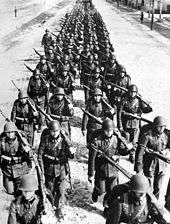 Infantry on the march shortly before the outbreak of World War II, 1939
Infantry on the march shortly before the outbreak of World War II, 1939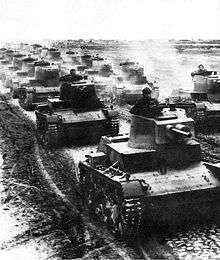 7TP tanks in formation; 1939 Defensive War
7TP tanks in formation; 1939 Defensive War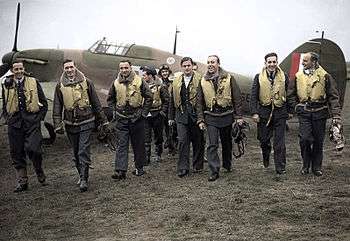 Airmen from No. 303 Polish Fighter Squadron during Battle of Britain
Airmen from No. 303 Polish Fighter Squadron during Battle of Britain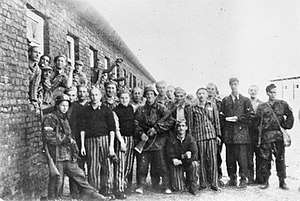 Home Army soldiers during Warsaw Uprising together with liberated Jewish prisoners of Gęsiówka Nazi German concentration camps
Home Army soldiers during Warsaw Uprising together with liberated Jewish prisoners of Gęsiówka Nazi German concentration camps Soldier of the 1st Polish Armoured Division in liberated Breda, 1944
Soldier of the 1st Polish Armoured Division in liberated Breda, 1944 Soldier of The Polish First Army raises Polish flag on the top of Berlin Victory Column on May 2, 1945
Soldier of The Polish First Army raises Polish flag on the top of Berlin Victory Column on May 2, 1945 Soldiers of the Polish People's Army
Soldiers of the Polish People's Army T-55 tanks during the communist government's imposed Martial law in Poland, 1981–1982
T-55 tanks during the communist government's imposed Martial law in Poland, 1981–1982 Polish Army as a part of peacekeeping force in Kosovo
Polish Army as a part of peacekeeping force in Kosovo
Organization
The Polish Armed Forces consist of 130,000[1] active duty and 62,000 active reserve personnel. In 2017, troop strength in the five different branches was as follows:
- Land Forces (Wojska Lądowe): 77,000[1]
- Air Force (Siły Powietrzne): 17,500[1]
- Navy (Marynarka Wojenna): 8,500[1] ~83 vessels[17]
- Special Forces (Wojska Specjalne): 2,500[18]
- Territorial Defence Force (Wojska Obrony Terytorialnej): 14,000 (as of October 2018; 53,000 planned by 2021)[19]
All five branches are supported by:
- Military infrastructure: 30,000[20] (Representing 39,8% of the entire active duty personnel), including:
- Ministry of National Defence of the Republic of Poland (Ministerstwo Obrony Narodowej)
- Central support
- Military command
- Supply and military logistics
- Military Gendarmerie (Żandarmeria Wojskowa): 4,500[18]
- Military reserve forces: 20,000 (Part-time volunteers which serve within the Land Forces, Navy and Air Force)[21]
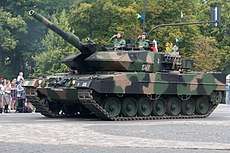 Leopard 2A5 main battle tank.
Leopard 2A5 main battle tank. AHS Krab self-propelled howitzer
AHS Krab self-propelled howitzer.jpg) KTO Rosomak infantry fighting vehicle
KTO Rosomak infantry fighting vehicle.jpg) Soldiers of the Polish Special Forces on Humvee
Soldiers of the Polish Special Forces on Humvee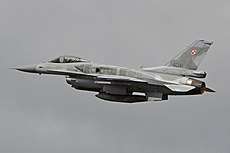 F-16 multirole fighter
F-16 multirole fighter.jpg) MiG-29 air superiority fighter
MiG-29 air superiority fighter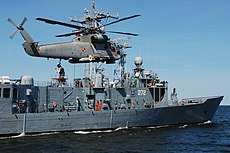 ORP Generał Kazimierz Pułaski guided-missile frigate and SH-2G Super Seasprite anti-submarine helicopter
ORP Generał Kazimierz Pułaski guided-missile frigate and SH-2G Super Seasprite anti-submarine helicopter- ORP Orzeł submarine
Equipment
As of 2011, the Armed Forces are in the middle of a long-term modernisation programme. Immediate plans involve new anti-aircraft missile systems, ballistic missile defence systems, a Lead-In Fighter Trainer (LIFT) aircraft, medium transport and combat helicopters, submarines, unmanned aerial vehicles, as well as self-propelled howitzers.
Technical modernisation plans for the years 2013 through to 2022 have been put in place.[22] During the 2013 to 2016 period of the plan, 37.8 billion PLN, or 27.8% of the period's military budget of 135.5 billion PLN was invested into technical modernisation.[22]
Significant military equipment acquisitions are also planned for the upcoming 2017 through 2022 period of the 2013–2022 technical modernisation plan, with the Ministry of Defense outlaying 61 billion złoty to be spent over the six-year span. A major feature of the program is the acquisition of around 1200 unmanned aerial vehicles, including at least 1000 with combat capabilities. Additionally, new helicopters and air defense systems are to be procured along with five light vessels for the navy. A new submarine force is to be jointly operated with a NATO partner, and general upgrade and modernization efforts are aimed at the country's air defenses, naval forces, cyber warfare capabilities, armored forces, and territorial defense forces (to have 50,000 volunteer members).[23]
Current equipment
Light weapons
| Type | Quantity | Significant Models | Notes |
|---|---|---|---|
| Personal firearms | ~200,000+ | wz. 1996 assault rifle PM-84 sub-machine gun WIST-94 semi-automatic pistol |
numerous types in limited use throughout the services |
| Infantry support weapons | ~30,000+ | PK machine gun NSW heavy machine gun wz. 74 grenade launcher |
|
| Mortars | ~540 | 60 mm LM-60D Pluton 120 mm wz. 38/43 |
|
| Portable anti-tank guided missiles | 364 | 9K111 Fagot Spike |
|
| Man-portable air-defense systems | 840 | Strela 2 PZR Grom |
|
Artillery
| Type | Quantity | Significant Models | Notes |
|---|---|---|---|
| Self-propelled howitzers | 443 | 122 mm 2S1 Goździk 152 mm wz. 1977 Dana 155mm AHS Krab |
2S1 Gvozdika was replaced by AHS Krab and SpGH Dana was replaced by AHS Kryl 120mm "RAK" mortar (model of KTO Rosomak) comes into service in 2017/2018 |
| Self-propelled multiple rocket launchers | 240 | 122 mm BM-21 Grad 122 mm WR-40 Langusta 122 mm RM-70 |
BM-21 and RM-70 to be replaced by "Homar" rocket artillery |
| Self-propelled surface-to-air missiles | 96 | S-125 Newa 9K33 Osa 2K12 Kub |
|
| Towed Surface-to-air missile launchers | 12 | S-200 Wega | 2 squadrons |
| Self-propelled anti-aircraft guns | ~100 | ZSU-23-4 tracked SPAAG Star truck-mounted 23 mm gun |
|
| Towed anti-aircraft guns | ~400 | 23 mm ZU-23-2 |
Land vehicles
| Type | Quantity | Significant Models | Notes |
|---|---|---|---|
| Main battle tanks | 1,010[24] | Leopard 2 A4, A5 PT-91 T-72M |
Leopard 2 A4 will be upgraded to Leopard 2 PL standard within Leopard program. (first Leopard 2 PL will arrive in March 2018). |
| Armoured fighting vehicles | 3,110[24] | BWP-1 tracked infantry fighting vehicle (To be replaced by "Borsuk" vehicle to 2019) KTO Rosomak wheeled infantry fighting vehicle MT-LB armored personnel carrier BRDM-2 scout car M113 |
|
| Armoured support vehicles | WZT-2, WZT-3 armored recovery vehicle TRI military engineering vehicle BLG-67 armored vehicle-launched bridge |
||
| Trucks and utility vehicles | ~8,000 | FSC Star Jelcz |
Numerous types in service throughout the services |
Aircraft
| Type | Quantity | Significant Models | Notes |
|---|---|---|---|
| Combat aircraft | 98 | F-16C/D Fighting Falcon MiG-29A/UB Su-22M4 |
F-16s equipped with 70 AGM-158 JASSM standoff air-launched cruise missiles; 40 AGM-158 JASSM-ER missiles to be introduced
MiG-29s and Su-22s to be replaced (programme Harpia) |
| Attack helicopters | 29 | Mil Mi-24 | For later replacement by new attack helicopters (programme Kruk) |
| Transport aircraft | 49 | C-130E Hercules CASA C-295 PZL M-28 |
|
| Transport helicopters | 113 | Mi-8 Mi-17 W-3 Sokol |
Mi-8/17 to be replaced. Mi-8 was replaced by new 8 combat SAR helicopters for Special Forces in 2017. |
| Training aircraft | 56 | TS-11 Iskra PZL-130 Orlik |
Alenia M-346 Master being introduced to July/August 2017 |
| Training helicopters | 54 | Mi-2 SW-4 |
|
| Maritime patrol aircraft | 9 | M28B Bryza 1R | |
| Naval helicopters | 23 | Mi-14 W-3 Sokol SH-2G Super Seasprite |
Used for anti-submarine warfare and search and rescue. MON buys new 8 search and rescue helicopters & to anti-submarines warfare for the Navy in 2017 |
| Unmanned aerial vehicles | 30 | Orbiter | Planned increase to 1200 in service by 2022 |
Total airpower: 461 aircraft
Naval vessels
Submarines:
- ORP Orzeł (291)
- ORP Bielik
- ORP Kondor
- ORP Sokół
- ORP Sęp
Frigates:
- ORP Gen. K. Pułaski
- ORP Gen. T. Kościuszko
Corvettes:
Patrol ships:
- ORP Ślązak (Will enter service in 2017/2018)
Mine destroyers:
- ORP Kormoran
- ORP Flaming
- ORP Mewa
- ORP Czajka
- ORP Gopło
- ORP Gardno
- ORP Bukowo
- ORP Dąbie
- ORP Jamno
- ORP Mielno
- ORP Wicko
- ORP Sarbsko
- ORP Necko
- ORP Nakło
- ORP Drużno
- ORP Hańcza
- ORP Mamry
- ORP Wigry
- ORP Śniardwy
- ORP Wdzydze
Transport-mines ships:
- ORP Lublin
- ORP Gniezno
- ORP Kraków
- ORP Poznań
- ORP Toruń
Logistics Support Ships:
Tankers:
Radio recognition ships:
- ORP Nawigator
- ORP Hydrograf
SAR ships:
- ORP Piast
- ORP Lech
- ORP Zbyszko
- ORP Maćko
Hydrographic vessels:
- ORP Heweliusz
- ORP Arctowski
Training ship:
- ORP Iskra
- ORP Wodnik
Ships-museum:
 ORP Toruń
ORP Toruń- ORP Bałtyk
- ORP Gen. Kazimierz Pułaski
- ORP Piorun
.jpg) ORP Kontradmirał Xawery Czernicki
ORP Kontradmirał Xawery Czernicki- ORP Orzeł
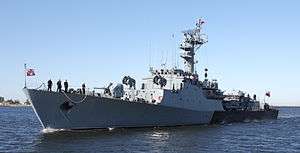 ORP Kaszub
ORP Kaszub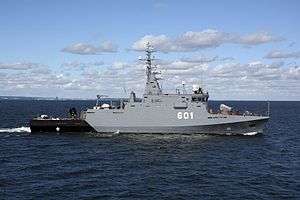 ORP Kormoran
ORP Kormoran- OORP Gen. Kazimerz Pułaski and Gen. Tadeusz Kościuszko
- ORP Grom
- ORP Sokół
- ORP Wdzydze
- ORP Poznań
.jpg) ORP Ślązak at the beginning of construction in 2015
ORP Ślązak at the beginning of construction in 2015
And other vessels
Total naval power: 83 vessels
Acquisition programs
Firearms
Poland has several ongoing acquisition efforts for firearms. The largest in quantity is the continuing delivery of FB Beryl and Mini-Beryl assault rifles of which over 28,000 are on order. Adopted in 1997, these weapons are continuing to replace Cold War-era infantry rifles that can still be found in some formations and stockpiles. Even with deliveries continuing, the military is developing a next-generation service rifle, the FB MSBS, which would be configurable for a number of different roles, including assault rifle, carbine, sniper rife, squad light machine gun, and perhaps even a combat shotgun. Sniper rifle acquisitions include 60 Bor rifles on order plus a planned acquisition of 250 new designated marksman rifles to replace the SWD. Modernization is planned for the machine gun arsenal with 368 UKM-2000P on order.
Helicopters
A major program to purchase 50 Eurocopter EC725 Caracal helicopters was announced in 2015. This would replace the Mi-8 and Mi-14 in service at a cost of PLN13.3 billion. [25] However, in October 2016, Poland dropped out of offset negotiations prior to concluding the deal.[26] The Defence Minister announced plans to instead purchase an initial two Sikorsky S-70 Black Hawk helicopters to be built in Poland, with another eight planned for 2017. This however was amended later in October, and an invitation given to Airbus Helicopters, Sikorsky, and Leonardo-Finmeccanica to enter discussions on providing helicopters. By December, the Ministry of Defence had officially launched a tender to procure fourteen military helicopters to meet urgent requirements.[27] Separately, to arm new helicopters, plans have been laid to acquire as many as 100 Miniguns.
.jpg) Leopard 2A5, main battle tank
Leopard 2A5, main battle tank KTO Rosomak in Afghanistan
KTO Rosomak in Afghanistan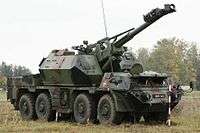 152mm SpGH DANA, self-propelled artillery
152mm SpGH DANA, self-propelled artillery_F-16C_Block_52_(6_ELT).jpg) F-16D block 52, multirole fighter aircraft
F-16D block 52, multirole fighter aircraft.jpg) MiG-29, fighter aircraft
MiG-29, fighter aircraft Polish Mi-24
Polish Mi-24 Polish PZL Sokół
Polish PZL Sokół Polish CASA
Polish CASA- WR-40 Langusta
 WZT-3
WZT-3 KTO Rosomak
KTO Rosomak Polish Navy helicopters: Mi-14, Mi-14PŁ, Kaman SH-2G Super Seasprite, PZL Anakonda
Polish Navy helicopters: Mi-14, Mi-14PŁ, Kaman SH-2G Super Seasprite, PZL Anakonda- Skorpion-3 (armored version of Honker)
 Polish Humvees in Iraq
Polish Humvees in Iraq
Personnel
The Polish Armed Forces are the only military entity in the world to use a two-finger salute which is only used while wearing a hat (it refers to the fact that the salute is given to the emblem itself) with the emblem of the Polish eagle, such as military hat rogatywka. The salute is performed with the middle and index fingers extended and touching each other, while the ring and little fingers are bent and touched by the thumb. The tips of the middle and index fingers touch the peak of the cap, two fingers supposedly meaning Honour and Fatherland (Honor i Ojczyzna).
Notes
- 1 2 3 4 5 6
- ↑ , In 2018 Poland will spend at least 2 percent of its GDP on defence
- ↑ Ministry of National Defence, Defence Strategy of the Republic of Poland Archived 2011-09-04 at the Wayback Machine., Warsaw, 2009. Strategic defence goals, p.7-8.
- ↑ see pl:III Korpus Polski (PSZ)
- ↑ "Chapter 5. The Polish contribution to the liberation of the Netherlands (1944–1945)". Polish forces in the West. Retrieved 2016-01-10.
- ↑ (in Polish) Wojsko Polskie we Francji. Świat Polonii. Sources give estimates that can differ by few percent.
- ↑ Andrew A. Michta, Red Eagle: The Army in Polish Politics 1944–1988, Hoover Press, 1990, p.44. Source see footnote 19, p.44
- ↑ Michta, 1990, p.59, citing the Polish army daily Żołnierz Wolności, April 12, 1968
- ↑ Michta, 1990, p.62. Michta's footnote emphasises that Spychalski would not have been the right officer to have in charge of the Armed Forces of the People's Republic of Poland during the invasion.
- ↑ Michta, 1990, p.62. Michta's footnote cites 'Testimony of traitor Col. Ryszard Kuklinski, who participated in the preparation of the invasion plans.' See Kuklinski p.10
- ↑ "Polish observers leave North Korea via Beijing". AP. 9 March 1995. Retrieved 3 June 2016.
- ↑ Ministry of National Defence, Missions, accessed November 2011
- ↑ Around 200 Polish soldiers took part in combat, including GROM and Formoza (Naval Frogmen Group) special forces, a chemical decontamination unit as well as the ORP Kontradmirał X. Czernicki logistical ship. (Rafał Domisiewicz, Consolidating the Security Sector in Post-Conflict States: Polish Lessons from Iraq, Austrian Ministry of Foreign Affairs)
- ↑ SWiSH v2.0. "Wojskowe misje ONZ z udziałem Polaków" (in Polish). Skmponz.w.interia.pl. Archived from the original on 2011-11-17. Retrieved 2011-11-20.
- ↑ Grzegorz Holdanowicz, 'Polish Joint HQ becomes operational,' Jane's Defence Weekly, 22 December 2004, p.5
- ↑ The Guardian,
- ↑ ":: Ministerstwo Obrony Narodowej – serwis internetowy :: Uzbrojenie ::". Mon.gov.pl. 2012-03-21. Archived from the original on 2012-03-02. Retrieved 2012-04-17.
- 1 2 http://www.dz.urz.mon.gov.pl/zasoby/dziennik/pozycje/zalaczniki/2013/02/Zal._do_Poz._49_2.pdf
- ↑ https://www.defence24.pl/rosnie-stan-osobowy-wojsk-obrony-terytorialnej
- ↑ "Archived copy". Archived from the original on 2010-10-11. Retrieved 2011-01-12.
- ↑ Onet.pl, Rewolucja w polskiej armii- Wiadomości Archived 2009-03-24 at the Wayback Machine., 21 March 2009
- 1 2 "Technical Modernisation of Polish Armed Forces 2013–2022". www.defense-aerospace.com. Retrieved 2017-02-16.
- ↑ "Poland To Spend $14.5 Billion For Military Procurement From 2017–2022". Defense Talk.com. 7 Dec 2016. Retrieved 7 Dec 2016.
- 1 2 Ministry of National Defence. ":: Ministerstwo Obrony Narodowej – serwis internetowy :: Uzbrojenie :: Archived 2012-03-02 at the Wayback Machine.".
- ↑ Glowacki, Bartosz. "Poland to launch attack helicopter talks with bidders." Flight International, 7 October 2015.
- ↑ "Poland drops Caracal Helicopter talks with Airbus" Defense News, 5 Oct 2016.
- ↑ "Poland launches tender for 14 army helicopters – ministry". Reuters. 1 Dec 2016. Retrieved 7 Dec 2016.
References
- Rafał Domisiewicz, Consolidating the Security Sector in Post-Conflict States: Polish Lessons from Iraq, Austrian Ministry of Foreign Affairs
- Andrew A. Michta, Red Eagle: The Army in Polish Politics 1944–1988, Hoover Press, 1990
- Ministry of National Defence, Defence Strategy of the Republic of Poland, Warsaw, 2009.
Further reading
- Remigiusz Wilk, "Work in Progress", Jane's Defence Weekly, 20 August 2012, and Jane's Interview, same issue
External links
| Wikimedia Commons has media related to Military of Poland. |
- Official website of the Ministerstwo Obrony Narodowej
- Official website of the Sztab Generalny Wojska Polskiego
- Official website of the Dowództwo Operacyjne Sił Zbrojnych
- Official website of the Żandarmeria Wojskowa
- kamouflage.net, Republic of Poland
- Pictures from Iraq of Polish Army
- All change as Poland boosts military spending via http://www.worldreview.info
- Polish forces in the West (historical account of Polish operations in Western Europe)
